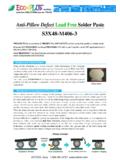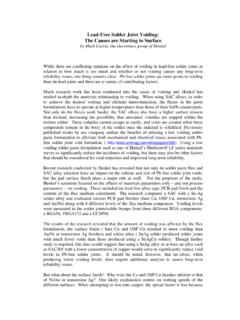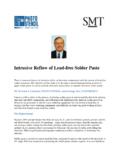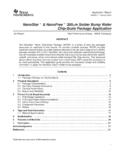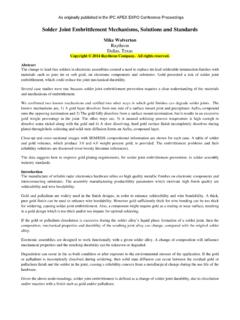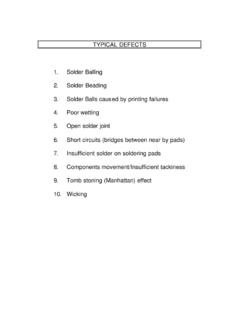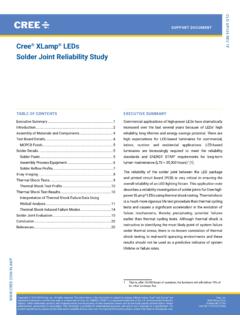Transcription of IPC-7351 & 7251 Padstack Naming Convention
1 IPC-7251 & 7351 Padstack Naming Convention INTRODUCTION. The Padstack consists of combinations of letters and numbers that represent shape, or dimensions of lands on different layers of printed boards or documentation. The name of the Padstack needs to represent all the various combinations. These are used in combination with the land pattern conventions defined herein according to the rules established in the IPC-2220 Design standards. The first part of the Padstack Convention consists of a land shape.
2 There are six basic land shape identifiers. Note: All alphabetical characters are lower case . This helps discriminate numeric values. Basic Land Shape Letters c = Circular s = Square r = Rectangle b = Oblong u = Contour (Irregular Shape). d = D Shape (Square on one end and Circular on the other end). Padstack Defaults Solder Mask is 1:1 scale of the land size Paste Mask is 1:1 scale of the land size The Assembly Layer land is 1:1 scale of the land size Inner Layer Land is the same shape as the outer layer land The Primary and Secondary lands are the same size The inner layer land shapes are Circular Vias are Circular Thermal ID, OD and Spoke Width sizes follow the IPC Level A, B or C.
3 Plane Clearance Anti-pad size follows the IPC Level A, B or C. Thermals have 4 spokes Mounting Holes are Circular Note: Every board fabricator's ability to register solder mask is different. The 1:1 scale solder mask covers the variation, and so long as manufacturers are building to specs such as IPC-6012 that say you can't have mis-registration of the solder mask. Illegal characters that cannot be used (Microsoft requirement) include , ; : / \ [ ] ( ) . { } * & % # $ ! @ ^ =. Examples utilizing the Padstack Naming Convention (all values are in metric units).
4 Note: Every number goes two places to the right and as many as needed to the left of the decimal Examples: 1150 = mm or 11500 m, 150 = mm or 1500 m, 15 = mm or 150 m c150h90 where c denotes a Circular land with a diameter and H denotes a hole size of v50h25 where a v denotes a via with a land (default Circular land) and H denotes a hole s150h90 where s denotes a Square land and H denotes a hole size of s350 where s denotes a square SMT land size of r200_100 where r denotes a Rectangular SMT land land length X land width b300_150 where b denotes a SMT Oblong land size of X b400_200h100 where b denotes an Oblong land size of length X width and hole d300_150 where d denotes land with one circular end and one square end (looks like a D) X v30h15l1-3 where v denotes a blind via with Hole.
5 1 is the starting layer, 3 is the end layer r200_100r5 = Rounded Rectangular 2mm X 1mm X radius corners r200_100c10 = Chamfered Rectangular 2mm X 1mm X chamfered corners v30h15l3-6 where v denotes a buried via with Hole; 3 is the starting layer, 6 is the end layer The through hole IPC-7251 file should be used as the basis for a new chart in IPC-7251. and IPC-7351B. Note: Draft supporting paragraphs with formula that document the math involved. It is assumed that the Padstack has the same value as the mounted layer size and shape for.
6 Inner Layer Opposite Side Solder Mask Solder Paste Assembly Layers It is also assumed that the Plane Clearance and Thermal Relief data follows the through-hole Convention guidelines defined in the IPC-2221 and IPC-2222 standards. Modifiers that are used when Padstack features are different than the defaults These are the Variants or Modifiers that go after the basic Padstack Naming Convention . These are used when the User needs to change the Padstack default values either by a different dimension or a different shape.
7 In instances where shapes are different this becomes a two letter code with the modifier first followed by the land shape letter. n = Non-plated Hole z = Inner Layer land dimension if different than the land on primary layer x = Special modifier used alone or following other modifiers for lands on opposite side to primary layer land dimension t = Thermal Relief; if different than IPC standard Padstack tid_od_sw for 4 spoke default m = Solder Mask if different than default 1:1 scale of land p = Solder Paste if different than default 1:1 scale of land a = Assembly surface land if different than default 1:1 scale of land y = Plane Clearance (Anti-pad) if the value is different than the Thermal OD.
8 O = Offset Land Origin k = Keep-out r = Radius for Rounded Rectangular Land Shape c = Chamfer for Chamfered Rectangular Land Shape Shape change is the last letter in the string prior to the dimension. Other usage of the Padstack Naming Convention USE of letter v: Vias can be named using the pad stack Naming Convention . Because most vias use lands that are circular in shape, the letter V will be used in place of the letter C in the Padstack Naming Convention . If this is not true the modifiers can be added after the letter V to signify shape or dimensional changes to this default.
9 USE of letter w: In addition to Vias the Padstack Naming Convention can also be used for defining mounting holes. The letter W shall be used to define the mounting hole characteristics and any associated lands used for the surface lands (either plated or un-plated). Examples of double character modifiers: ts = Thermal Square; if different than the top side land shape and dimensions sw = Thermal spoke width zs = Inner Layer Land Shape is Square (Note: The default is circular). m0 = No Solder Mask mxc = Solder Mask Opposite Side Circular mx0 = Solder Mask Opposite Side No Solder Mask xc = Opposite Side Circular vs = Via with Square land hn = Non-plated Hole Modifier Example for Through-hole: s150h90zs150 = where s is Square land with Hole with inner (Z) Layer Square land c150h90zc150 = where c is Circular land with Hole with inner (Z) Layer Circular land Modifier Examples for Vias.
10 Vs50h25 where vs denotes a Square Via with a Hole v50h25xs70 where v is Circular Via with Hole and Square land on opposite side Chamfered & Rounded corner modifiers are used to indicate which corner(s) are modified. Order of precedence has been given to the first 4 modifiers. 1 2. _bl _br 3 4. _ul __ur Modifiers: bl bottom left br bottom right ul upper left ur upper right ulr upper left & right blr bottom left & right ubl upper and bottom left ubr upper and bottom right Rounded and Chamfered lands in one corner Modifier Examples.
